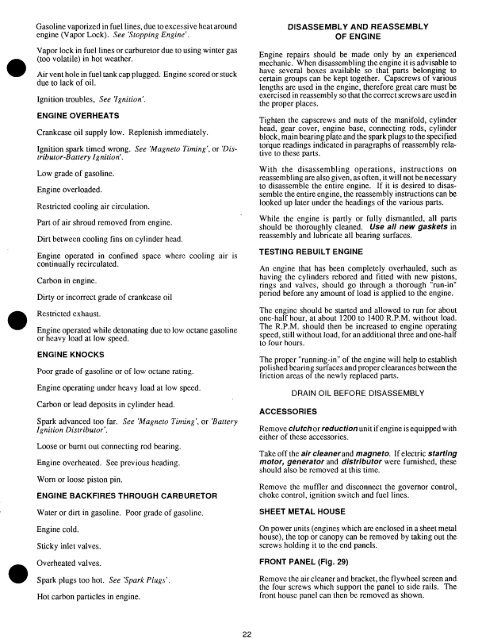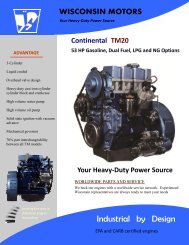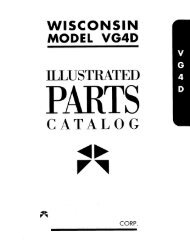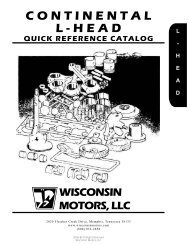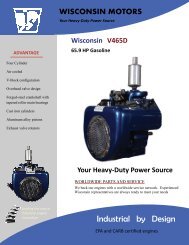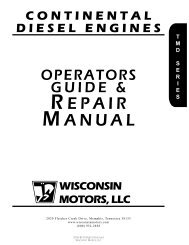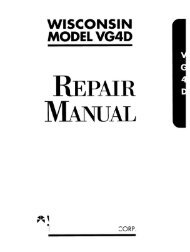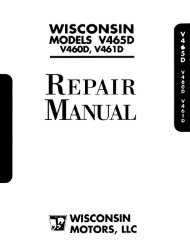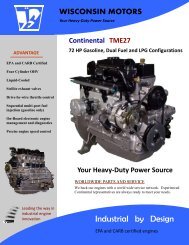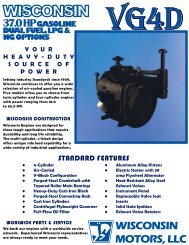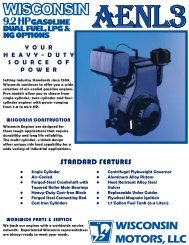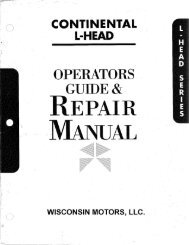W2-880 Tjd, Thd, Th - Repair - Wisconsin Motors
W2-880 Tjd, Thd, Th - Repair - Wisconsin Motors
W2-880 Tjd, Thd, Th - Repair - Wisconsin Motors
You also want an ePaper? Increase the reach of your titles
YUMPU automatically turns print PDFs into web optimized ePapers that Google loves.
22<br />
Gasoline vaporized in fuel lines, due to excessive heat around<br />
engine (Vapor Lock). See ’Stopping Engine’.<br />
Vapor lock in fuel lines or carburetor due to using winter gas<br />
(too volatile) in hot weather.<br />
Air vent hole in fuel tank cap plugged. Engine scored or stuck<br />
due to lack of oil.<br />
Ignition troubles, See ’Ignition’.<br />
ENGINE OVERHEATS<br />
Crankcase oil supply low. Replenish immediately.<br />
Ignition spark timed wrong. See "Magneto Timing’, or ’Distributor-Battery<br />
Ignition’.<br />
Low grade of gasoline.<br />
Engine overloaded.<br />
Restricted cooling air circulation.<br />
Part of air shroud removed from engine.<br />
Dirt between cooling fins on cylinder head.<br />
Engine operated in confined space where cooling air is<br />
continually recirculated.<br />
Carbon in engine.<br />
Dirty or incorrect grade of crankcase oil<br />
Restricted exhaust.<br />
Engine operated while detonating due to low octane gasoline<br />
or heavy load at low speed.<br />
ENGINE KNOCKS<br />
Poor grade of gasoline or of low octane rating.<br />
Engine operating under heavy load at low speed.<br />
Carbon or lead deposits in cylinder head.<br />
Spark advanced too far. See ’Magneto Timing’, or "Battery<br />
Ignition Distributor’.<br />
Loose or burnt out connecting rod bearing.<br />
Engine overheated. See previous heading.<br />
Worn or loose piston pin.<br />
ENGINE BACKFIRES THROUGH CARB URETOR<br />
Water or dirt in gasoline. Poor grade of ga~;oline.<br />
Engine cold.<br />
Sticky inlet valves.<br />
Overheated valves.<br />
Spark plugs too hot. See ’Spark Plugs’.<br />
Hot carbon particles in engine.<br />
DISASSEMBLY AND REASSEMBL¥<br />
OF ENGINE<br />
Engine repairs should be made only by an experienced<br />
mechanic. When disassembling the engine it is advisable to<br />
have several boxes available so that parts belonging to<br />
certain groups can be kept together. Capscrews of various<br />
lengths are used in the engine, therefore great care must be<br />
exercised in reassembly so that the correct screws are used in<br />
the proper places.<br />
Tighten the capscrews and nuts of the manifold, cylinder<br />
head, gear cover, engine base, connecting rods, cylinder<br />
blgck, main bearing plate and the spark plugs to the specified<br />
torque readings indicated in paragraphs of reassembly relative<br />
to these parts.<br />
With the disassembling operations, instructions on<br />
reassembling are also given, as often, it will not be necessary<br />
to disassemble the entire engine. If it is desired to disassemble<br />
the entire engine, the reassembly instructions can be<br />
looked up later under the headings of the various parts.<br />
While the engine is partly or fully dismantled, all parts<br />
should be thoroughly cleaned. Use all new gaskets in<br />
reassembly and lubricate all bearing surfaces.<br />
TESTING REBUILT ENGINE<br />
An engine that has been completely overhauled, such as<br />
having the cylinders rebored and fitted with new pistons,<br />
rings and valves, should go through a thorough "run-in"<br />
period before any amount of load is applied to the engine.<br />
<strong>Th</strong>e engine should be started and allowed to run for about<br />
one-half hour, at about 1200 to 1400 R.P.M. without load.<br />
<strong>Th</strong>e R.P.M. should then be increased to engine operating<br />
speed, still without load, for an additional three and one-half<br />
to four hours.<br />
<strong>Th</strong>e proper "running-in" of the engine will help to establish<br />
polished bearing surfaces and proper clearances between the<br />
friction areas of the newly replaced parts.<br />
ACCESSORIES<br />
DRAIN OIL BEFORE DISASSEMBLY<br />
Remove clutch or reduction unit if engine is equipped with<br />
either of these accessories.<br />
Take off the air cleanerand magneto. If electric starting<br />
rnotor~ generator and distributor were furnished, these<br />
should also be removed at this time.<br />
Remove the muffler and disconnect the governor control,<br />
choke control, ignition switch and fuel lines.<br />
SHEET METAL HOUSE<br />
On power units (engines which are enclosed in a sheet metal<br />
house), the top or canopy can be removed by taking out the<br />
screws holding it to the end panels.<br />
FRONT PANEL (Fig. 29)<br />
Remove the air cleaner and bracket, the flywheel screen and<br />
the four screws which support the panel to side rails. <strong>Th</strong>e<br />
front house panel can then be removed as shown.


